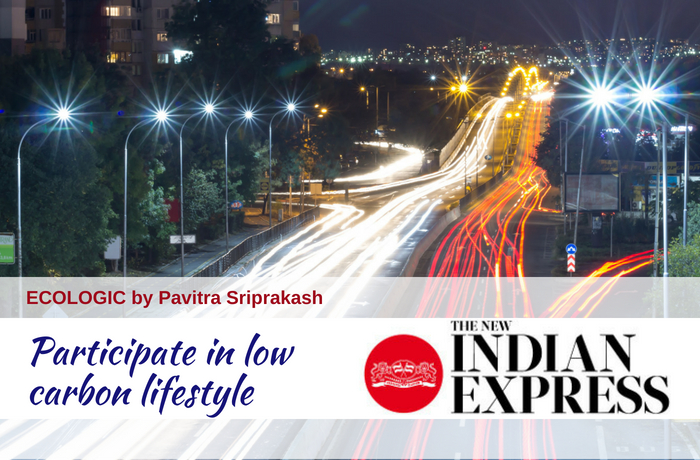08-Sept-18: Pavitra Sriprakash, Director and Chief Designer, Shilpa Architects Planners Designers Pvt. Ltd. writes a weekly column on Sustainability for The New Indian Express titled “ECOLOGIC”. This week’s article highlights the importance of participating in and adopting a “Low Carbon” lifestyle.
According to the World Health Organisation, India has 14 out of the 15 most polluted cities in the world in terms of particulate matter (PM) 2.5 concentrations. The worst is Kanpur with a PM 2.5 concentration of 173 micrograms per cubic metre. Creditably no south Indian city figured in this WHO’s global air pollution report, perhaps because of their better pollution controls and higher humidity.
One long term solution for improving air quality is to design low carbon lifestyles for people to commute without depending on internal combustion engines for mobility. Transit Oriented Development (TOD), is at the heart and soul of sustainability, and brings together compact, walkable communities with high quality rail systems. This type of lifestyle can reduce energy consumption. Well designed TOD empowers people to walk, cycle, or take public transportation. They provide greater transit accessibility and a mix of uses. This is an urban development response to traffic congestion, carbon emissions, suburban sprawl and inefficiency of cars that mostly transport just one occupant per trip.
TOD is a set of transportation and land use planning strategies that connects communities with vibrant, people-centric places in cities. Stations are located with highest ridership potential and development opportunities. A radius of about 1km around stations are designated for higher density, mixed-use, walkable development, tapering down to residential neighborhoods. The station sites are designed for seamless pedestrian connections to surrounding developments, with public plazas directly fronting the station building.
Retail and cafe streets lead to station entrances along main pedestrian connections. Multilevel parking at station sites are provided 200 to 400 metres away with pedestrian flow along retail streets. Multi-modal connections from these makes transfers easy, direct, and comfortable. Incorporating bikeshare, and a comprehensive bikeway network serves to catalyse major redevelopment and place making. Of course design concepts and details will vary depending on location, context, availability of redevelopment property, surrounding development, etc.
Combining a national High Speed Rail network with dense, walkable TODs around all the stations will significantly reduce congestion and dependence on cars while cutting carbon emissions by epic proportions. The entire system can be powered by renewable energy. Electric trains are a major form of daily transportation in numerous countries, and are the single most powerful transportation choice that can solve serious mobility, energy, environmental, economic, health, and social problems simultaneously on a global scale.
When combined with extensive rail systems, TODs complete the sustainable community model as stand-alone communities, or a series of towns strung along a rail line like pearls on a string. The public worldwide have embraced these concepts, and real estate developers have quickly followed to meet the high demand for quality urban places served by rail systems. This is not only because TOD can offer a higher quality of life, but because it offers a triple bottom line solution to economic, social, and environmental sustainability.
As urban air quality declines, the risk of stroke, heart disease, lung cancer, and chronic and acute respiratory diseases increases. As responsible citizens we should demand our city officials and governments to embrace this modern urban development model now. And wherever these are implemented at huge costs we should welcome the initiatives and participate in their success. Will you, please?
Pavitra Sriprakash
Twitter@pavisriprakash
The writer is an architect, urban designer, dancer and chief designer at Shilpa Architects



